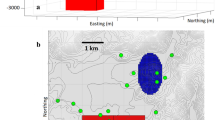Abstract
This paper shows the potential of gravity data to map a buried landfill bottom topography. To this end, a gravity inversion method is presented for estimating the landfill’s bottom depths at discrete points assuming a decrease of the density contrast with depth according to a hyperbolic law. The method’s efficiency was tested using synthetic data from simulated waste landfills, producing estimated bottom topographies very close to the true ones. The method’s potentiality has been further evaluated in applying it to the gravity data from the abandoned Thomas Farm Landfill site, Indiana, USA, whose bottom topography is known. The estimated topography showed close agreement with the known Thomas Farm Landfill’s bottom topography.








Similar content being viewed by others
References
Angoran Y, Madden TR (1977) Induced-polarization—a preliminary study of its chemical basis. Geophysics 42:788–803
Barbosa VCF, Menezes PTL, Silva JBC (2007) Gravity data as a tool for detecting faults: in-depth enhancement of subtle Almada’s basement faults, Brazil. Geophysics 72:B59–B68
Barbosa VCF, Silva JBC, Medeiros WE (1997) Gravity inversion of basement relief using approximate equality constraints on depth. Geophysics 62:1745–1757
Barbosa VCF, Silva JBC, Medeiros WE (1999) Gravity inversion of a discontinuous relief stabilized by weighted smoothness constraints on depth. Geophysics 64:1429–1438
Beamish D, Mattsson A (2003) Time-lapse airborne EM surveys across a municipal landfill. J Environ Eng Geophys 8:157–165
Bernstone C, Dahlin T, Ohlsson T, Hogland W (2000) DC-resistivity mapping of internal landfill structures: two pre-excavation surveys. Environ Geol 39:360–371
Büker F, Green AG, Horstmeyer H (1998) Shallow seismic reflection study of a glaciated valley. Geophysics 63:1395–1407
Buselli G, Barber C, Davis GB, Salama RB (1990) Detection of groundwater contamination near waste disposal sites with transient eletromagnetic and eletrical methods. In: Ward SH (ed) Geotechnical and environment geophysics, vol 2, Environmental and Groundwater. SEG, Tulsa, pp 27–39
Chambers JE, Kuras O, Meldrum PI, Ogilvy RD, Hollands J (2006) Electrical resistivity tomography applied to geologic, hydrogeologic, and engineering investigations at a former waste-disposal site. Geophysics 71:B231–B239
De Iaco R, Green AG, Maurer HR, Horstmeyer H (2003) A combined seismic reflection and refraction study of a landfill and its host sediments. J Appl Geophys 52:139–156
Green AG, Lanz E, Maurer H, Boerner D (1999) A template for geophysical investigations of small landfills. Leading Edge 18:248–254
Hinze WJ (1990) The role of gravity and magnetic methods in engineering and environmental studies. In: Ward SH (ed) Geotechnical and environmental geophysics I, review and tutorial. SEG, Tulsa, pp 75–126
Kick IF (1989) Landfill investigations in New England using gravity methods. Symposium on the application of geophysics to engineering and environmental problems, pp 339–353
Lanz E, Pugin A, Green A, Horstmeyer H (1996) Results of 2-D and 3-D high-resolution seismic reflection surveying of surficial sediments. Geophys Res Lett 23:491–494
Lanz E, Maurer H, Green AG (1998) Refraction tomography over a buried waste disposal site. Geophysics 63:1414–1433
Litinsky VA (1989) Concept of effective density: key to gravity determinations for sedimentary basins. Geophysics 54:1474–1482
Marquardt DW (1963) An algorithm for least-squares estimation of nonlinear parameters. J Soc Ind Appl Math 2:601–612
Martinho E, Almeida F (2006) 3D behaviour of contamination in landfill sites using 2D resistivity/IP imaging: case studies in Portugal. Environ Geol 49:1071–1078
Pellerin L, Alumbaugh DL (1997) Tools for electromagnetic investigation of the shallow subsurface. Leading Edge 16:1631–1638
Prezzi C, Orgeira MJ, Ostera H, Vásquez CA (2005) Ground magnetic survey of a municipal solid waste landfill: pilot study in Argentina. Environ Geol 47:889–897
Rao VC, Chakravarthi V, Raju ML (1994) Forward modelling: gravity anomalies of two-dimensional bodies of arbitrary shape with hyperbolic and parabolic density functions. Comput Geosci 20:873–880
Roberts RL, Hinze WJ, Leap DI (1990). Data enhancement procedures on magnetic data from landfill investigations. In: Ward SH (ed) Geotechnical and environmental geophysics, vol 2, Environmental and Groundwater. SEG, Tulsa, pp 261–266
Roberts RL, Hinze WJ, Leap DI (1991) Application of the gravity method to investigation of a landfill in the glaciated midcontinent, U.S.A Invest Geophys 2(5):253–259
Rodriques EB (1987) Application of gravity and seismic methods in hydrogeological mapping at a landfill site in Ontario. First outdoor action conference on aquifer restoration, ground water monitoring and geophysical methods, pp 487–504
Ross HP, Mackelprang CE, Wright TPM (1990) Dipole-dipole electrical resistivity surveys at waste disposal study sites in northern Utah. In: Ward SH (ed) Geotechnical and environmental geophysics, vol 2. SEG, Tulsa, pp 145–153
Silva JBC, Costa DCL, Barbosa VCF (2006) Gravity inversion of basement relief and estimation of density contrast variation with depth. Geophysics 71:J51–J58
Silva JBC, Medeiros WE, Barbosa VCF (2001) Pitfalls in nonlinear inversion. Pure Appl Geophys 158:945–964
Splajt T, Ferrier G, Frostick LE (2003) Application of ground penetrating radar in mapping and monitoring landfill sites. Environ Geol 44:963–967
Tikhonov AN, Arsenin VY (1977) Solutions to Ill-posed problems. Wiley, New York
Zacher G, Tezkan B, Neubauer FM, Hordt A, Muller I (1996) Radiomagnetotellurics, a powerful tool for waste site exploration. Eur J Environ Eng Geophys 1:139–160
Acknowledgments
We thank the editor-in-chief Philip LaMoreaux and an anonymous reviewer whose constructive comments have helped to improve the paper. Conselho Nacional de Desenvolvimento Cientàfico e Tecnológico (CNPq), Brazil, supported the authors in this research. Additional support for V.C.F. Barbosa was provided by FAPERJ (Fundação Carlos Chagas Filho de Amparo à Pesquisa do Estado do Rio de Janeiro) under contract E-26/100.688/2007 and CNPq under contracts: 474878/2006-6 and 471913/2007-3.
Author information
Authors and Affiliations
Corresponding author
Rights and permissions
About this article
Cite this article
Silva, J.B.C., Teixeira, W.A. & Barbosa, V.C.F. Gravity data as a tool for landfill study. Environ Geol 57, 749–757 (2009). https://doi.org/10.1007/s00254-008-1353-6
Received:
Accepted:
Published:
Issue Date:
DOI: https://doi.org/10.1007/s00254-008-1353-6




